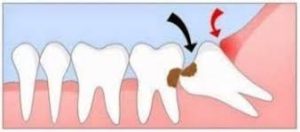 Wisdom teeth are third molars that are commonly coming in between the ages of 17 and 21. Historically, these teeth have been called wisdom teeth because they come through at a more mature age.
Wisdom teeth are third molars that are commonly coming in between the ages of 17 and 21. Historically, these teeth have been called wisdom teeth because they come through at a more mature age.
Wisdom teeth can lead to problems if there isn’t enough space for them to fully erupt, or they come through in the wrong position (please, see the picture). Impacted wisdom teeth should be removed before their root structure is fully developed. It may be in the patients at the age between mid-teenage and early 20th.Problems tend to occur with increasing frequency after the age of 30.
Some of the possible problems related to not removing your wisdom teeth include:
-
Wisdom teeth that haven’t come in properly, which can make it difficult to floss between the wisdom teeth and the molars next to them. This can cause an infection to develop.
-
When wisdom teeth are partially erupted, the opening around the teeth creates a place for infection to occur. This may also lead to pain, swelling and stiffness in your jaw.
-
Wisdom teeth that don’t have room to come through are thought by some to crowd or damage neighboring teeth.
-
A wisdom tooth that is impacted can form a cyst on or near the impacted tooth. This could damage the roots of nearby teeth or destroy the bone that supports your teeth.
Removal of the impacted teeth usually resolves these problems. Early removal is recommended to avoid such future problems and to decrease the surgical risk involved with the procedure. Your dentist may also recommend removal of wisdom teeth as part of treatment for braces or other dental care.
Once it has been determined that a wisdom tooth is problematic, extraction by an oral surgeon is usually indicated. Local anesthesia is administered to ensure the tooth can be pulled out without any major discomfort. Many people will choose conscious sedation (being put into a sleepy state where pain signals are blocked) so they have little or no memory of having the wisdom teeth extracted. A minor surgery is then performed where the tissue and bone around the wisdom tooth are removed so that the tooth can be cleanly extracted from the socket. Several stitches may be needed to close the surgical site and promote healing of the overlying tissue. These stitches may either be dissolvable stitches that come out on their own after three to five days or stitches that need to be removed by the surgeon during a follow-up appointment in one week after the procedure.
The initial recovery and healing from wisdom tooth extraction usually occurs over about three to five days. It is normal to have slight bleeding (oozing) from the site considering the surgical procedure performed. The minor bleeding after extraction should start to ease after the first 24 hours. When the anesthesia wears off, there may be jaw stiffness, difficulty opening the mouth all the way, and some pain. Pain medication is often prescribed to help with any postoperative symptoms and discomfort. Some patients may be prescribed antibiotics. The patient will be asked to eat soft foods for a few days and avoid spicy foods, smoking and alcohol use, and excessive exercise for three to four days following surgery. Adhering to the postoperative instructions of the surgeon is important to minimize any complications. Complete healing of the gums may take three to four weeks.
If you have any questions, please do not hesitate to call us at phone number: (661)246-4334.
Click Here to Download this E-book for further information:
Wisdom Teeth Management videos:

 Wisdom teeth are third molars that are commonly coming in between the ages of 17 and 21. Historically, these teeth have been called wisdom teeth because they come through at a more mature age.
Wisdom teeth are third molars that are commonly coming in between the ages of 17 and 21. Historically, these teeth have been called wisdom teeth because they come through at a more mature age.